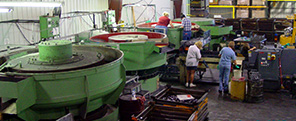Vibratory Finishing Basics
Vibratory finishing is a mechanical abrasive process used to clean, dry, deburr, descale, or deflash metal (or occasionally, plastic) parts. It is also used to polish or otherwise enhance part surface properties – or appearance.
Vibratory finishing is a subset of “mass finishing,” a collection of processes which also includes rotary (barrel) tumbling and can be used to harden and stress relieve parts, (roller bearings as one example) as well as modify surface properties.
Vibratory finishing is widely done by oems, contract shops, metal fab houses and some platers, where it’s used to prep parts for plating, anodizing and black oxide.
Vibratory machines range from traditional tumbling barrels to high energy, centrifugal disk systems to drag finishers, an ultra-high speed method engineered for parts made from high-alloy or tool steels, or those that are otherwise hard to machine.
Whatever the machinery however, what enables vibratory finishing to work is the media that’s used, and perhaps even more important, the chemistry that surrounds it.
Why cleaner chemistry matters
Good vibratory cleaner chemistry keeps the parts clean, and separated; it also keeps the media clean and prevents glazing– something that’s critical if the process is to produce the desired result. A good vibratory cleaner is also multi-metal compatible, multi-process compatible and multi-media compatible.
What to look for
No one vibratory cleaner chemistry suits every application, but the best formulas offer wide application ranges; they also have operations characteristics – 8 to be exact – that make life easier – and minimize costs – for operators and owners.
- Specifically, they:
- Are non-flammable
- Work in hard water
- Are water-soluble
- Have a mild (or no) odor
- Are low-foaming
- Do not stain parts
- Help keep bowls residue-free
- Simplify waste treatment
Acculube field specialists have worked with manufacturing managers and machine shop operators for more than 50 years. We understand the types of products that are most effective, long-term, in metalworking environments, and are proud to supply industry’s most popular branded fluids, including Mobil, Castrol, Houghton, and Henkel.
Recently, we added another important brand to our product family. Acculube now represents Finishing Technology’s Vibratory Products. Finishing Technology Inc. is a well-established manufacturer of high quality specialty chemical products and equipment for mass finishing. These vibratory cleaners deliver everything customers have said they want: multi-metal, multi-process, and multi-media compatibility, plus the 8 critical operational advantages bulleted above.
Choosing a vibratory cleaner is much like choosing other facility fluids: you want products that are proven, that are flexible, that are economical, and that will be trouble-free. The vibratory cleaners from Finishing Technology deliver all of that. Equally important, they come with great applications advice – and the ability to do test runs before you buy.
Click here for the list
We’re eager to talk with you about the cleaners you’re using, and to see whether one of these formulas can do more for your vibratory process – and more for your bottom line.
NEXT ESSAY
 |
|
Talk with Us Today
Call the metalworking experts at Acculube – we’ll help you get the most value from vibratory compounds and all of the critical fluids you buy, and avoid the pitfalls that can cost you money.
Contact Us: 1.800.404.2570 or email us at sales@acculube.com
|
|


